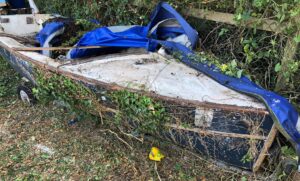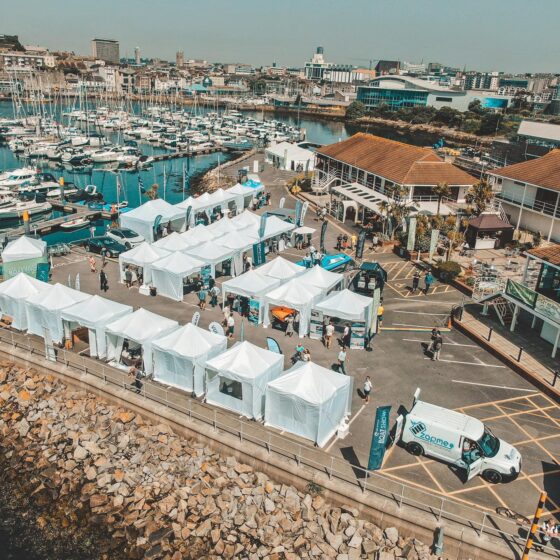
Composite waste recycling: will a new UK project be the silver bullet?

A new UK consortium plans to lead the world in high-level composite waste processing, recycling and reuse – Blue Composites Project’s James Scott-Anderson discusses why the industry cannot afford to continue to look the other way.
Approach a bank with the following business proposition: take what is rated as hazardous material waste, spend millions of pounds to bury it in the ground and then repeat on an annual basis. One wouldn’t get very far. Shamefully, though, this is the current solution in the UK for the majority of our composite waste.
In 2019, Composites UK estimated that in England alone, £29 million was spent on commercially landfilling composite waste. For a G7 nation where composites are being used across multiple sectors and often in the production of high-value luxury products, this is simply unacceptable. Neither should a situation be tolerated where highly polluting boats can be abandoned anywhere, causing high-impact, environmental damage.
Composite waste recycling – Blue Parameters
In the marine industry, the challenge of end-of-life boats (EOL) continues to be a pressing concern. There is no requirement for fully registered boat ownership in the UK, or a centralised database with this information, so it is almost impossible to track down the owners of abandoned EOL vessels. The cost of dealing with EOL vessels is a lengthy one, expensive and invariably falls on the marina or local authority. We also have no proper facilities where boats and composite waste can be processed at a high level.
The UK’s Blue Composites Project has been set up to change this. Announced at the Green Tech Boat Show in June 2022 and headed up by new sustainability consultancy Blue Parameters, the Blue Composites Project is aiming to create the UK’s first glass fibre composites recycling and reuse facility. Made up of some of the UK’s leading marine companies, composites specialists, academic institutions and local government organisations, the Blue Composites Project will not only look at the process of recycling composite materials but also how the reclaimed materials and fibres could be repurposed for use in new composite components.

The composite waste recycling consortium is setting up a research and development group at Plymouth University, which will take upcycled composite materials and test them to assess their mechanical properties and potential future applications. By quantifying the mechanical properties of the upcycled composite materials and resins the team can better understand the most suitable applications within existing supply chains and/or manufacturing processes.
The Blue Composites Project will identify waste streams and offer all sectors that use FRP and GRP – from the offshore wind industry and construction to automotive and marine – the opportunity to rethink the way waste material is used. By engaging with designers and engineers to see where the opportunities are for repurposing and using upcycled materials, we can reduce the amount of composite reaching landfill and educate industry and consumers alike.
The tech solutions
Blue Composites consortium member BM Longworth, a Blackburn-based company, has developed its Deecom technology, which can process composite waste at a level where reuse of not just reclaimed fibres, but glues, resins and coatings could be achieved. Polymer manufacturer Scott Bader is supporting testing and analysis of these materials, which may lead to a significant step in life cycle assessment (LCA) for composites and adhesives.
Kevin Matthews, CEO at Scott Bader, says: “Composites have the potential for increasing bio-based composition. An effective EOL solution could result in composites becoming environmentally very attractive as minimal waste and the materials of choice for an even broader range of applications. The project is a really important step in scoping out this future path to sustainability.”
“One of the key aspects of the Deecom process is that it separates everything out – so you get fibres, gelcoat, glue, and resins. Scott Bader believes it will be possible to take an awful lot of the separate materials and put them back into the manufacturer of resins, gels and hardeners – thus creating a complete LCA,” explains Simon de la Rue, founder of Blue Parameters.
UK circular economy specialist Oakdene Hollins is supporting the Blue Composites Project with technical and environmental analysis – including a formal LCA of the process. Peter Lee, Oakdene Hollins’ head of operations, says: “Oakdene Hollins is happy to support this pioneering project; focused on an often underreported waste stream, enabling high-quality recycling and boosting the uptake of quality secondary raw materials.”
For the marine sector, the project aims to eventually disassemble boats with the same precision with which they’re built – so if there are 300 stainless steel screws in the deck, we get 300 stainless steel screws out.
“Developing processes to take EOL vessels, and understanding recycling methods that will maximise the reuse of all materials, while also looking at the way they are built and designed and how that could be improved in the future with end of life in mind is critical for the future,” adds de la Rue.
The UK to lead the world
Composite waste recycling has never been approached in this way, but the UK has the unique opportunity to lead the world in composite processing, certification, recycling and reintroduction. We have every piece of the jigsaw needed to begin the testing process and set up the first dedicated facility of its kind. We have identified an ideal site in the southwest of England and have approval from the local authority for its use. We are now looking to secure funding for the next stages.
This is not going to be a high value or quick return, and the cost of upcycled materials is going to be more expensive than new. However, the landscape is changing with a growing global awareness that there is a price to pay for long-term sustainability.
Advanced waste management, extended producer responsibility and growing consumer demand for proven sustainable practices, and verifiable ESG, is building. The UK government is committing to high targets and the new Environment Bill is expected to push this agenda.
“Done correctly and combining BM Longworth’s technology with mechanical property testing could make it feasible to reuse material otherwise destined for landfill – and find applications for secondary materials in things like bus shelters, in garden panels, in caravans,” says de la Rue. “But we have just got to simply stop burying this stuff in the ground – composite waste has been filed under the ‘it’s too difficult’ category for far too long now.
“UK industry has a responsibility to address the issues of composite waste. And if protecting our environment isn’t sufficient motivation for some, consider the benefits to business. Supply chain issues have been impacting all sectors. If we can get LCA and quality secondary raw materials,
it could result in panels, materials and resins arriving from 20 miles down the road, as opposed to being imported from overseas.”
The Blue Composite Project has spoken to businesses across a wide range of industries that use composites and has found a clear appetite for composite recycling and upcycled materials. Other factors may also bring this issue into the fore – the UK has to address the challenge posed by the increasing use of wind turbines and how to process the blades when they reach end of use. It is estimated that there will be tens of thousands of tonnes of GRP and FRP from EOL wind turbine blades by 2031.
In the longer term, LCA will become a standard practice across manufacturing. The technology and ability to take what is hazardous waste and repurpose it exists. The way we deal with EOL vessels can and should change. We must change, we must recycle. This should not be a choice; this is a requirement for a sustainable future for all.
This article was first published in Marine Industry News‘ print edition, distributed at Southampton International Boat Show 2022.
